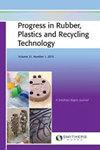回收高冲击聚苯乙烯:循环经济商业模式下的材料特性和再加工
IF 1.6
4区 材料科学
Q4 MATERIALS SCIENCE, COMPOSITES
Progress in Rubber Plastics and Recycling Technology
Pub Date : 2023-05-09
DOI:10.1177/14777606231168653
引用次数: 0
摘要
介绍了成功实施的扩展生产者责任(EPR),回收高价值产品,以帮助克服障碍,并建立向循环经济(CE)商业模式发展的信心。通过描述在实施高冲击聚苯乙烯(HIPS)的回收和再利用过程中的适当测试和考虑因素,为建议回收热塑性塑料的组织提供了一个模板,该模板基于实际的工业案例。模拟生产废料的100%闭环重复再加工,原HIPS经过注塑成型生产拉伸和冲击试验件,8次重新研磨和再加工。评估目前的结果和文献,生产废料的重复回收是可能的,而不需要补救复合步骤,或改变处理参数。EPR模型的组成部分是回收报废(EoL)产品中的塑料,并且与使用环境有关,紫外线照射对原始材料影响的研究表明,可能会发生显着的性能退化。然而,在室内使用,如在本案例中,没有看到这一点。在CE商业模式中,希望使用来自不同原始树脂制造商的回收HIPS的混合物。将干燥混合料直接送入成型机证明是令人满意的,避免了复合/制粒步骤的需要。作为这项研究的结果,产品正成功地从EoL产品中回收100%的HIPS,在环境和经济上都是积极的CE计划。本文章由计算机程序翻译,如有差异,请以英文原文为准。
Recycling high impact polystyrene: Material properties and reprocessing in a circular economy business model
An account is presented of successfully implemented Extended Producer Responsibility (EPR) with recycling to high value products, to help overcome barriers and generate confidence in moving towards Circular Economy (CE) business models. A template for organisations proposing to recycle a thermoplastic is provided by describing appropriate tests and considerations in implementing the recovery and re-use of high impact polystyrene (HIPS) based on a practical, industry case. Simulating the repeated 100% closed loop reprocessing of production scrap, original HIPS has been injection molded to produce tensile and impact test pieces, reground and reprocessed eight times. Assessing the present results together with literature, repeated recycling of production scrap is possible without the need for a remedial compounding step, or changes to processing parameters. Integral to the EPR model is recovery of plastic from returned end-of-life (EoL) products, and in relation to the in-use environment, studies of the effects of UV exposure on virgin material show that significant property degradation can occur. However, with indoor use, as in the present case, this is not seen. Within the CE business model it is desirable to use blends of recovered HIPS originating from different original resin manufacturers. Feeding dry blend regrind directly to the molding machine proved satisfactory, avoiding the need for a compounding/pelletizing step. As an outcome of this study, products are being successfully manufactured from 100% HIPS recovered from EoL products in an environmentally and economically positive CE plan.
求助全文
通过发布文献求助,成功后即可免费获取论文全文。
去求助
来源期刊

Progress in Rubber Plastics and Recycling Technology
MATERIALS SCIENCE, COMPOSITES-POLYMER SCIENCE
CiteScore
4.40
自引率
7.70%
发文量
18
审稿时长
>12 weeks
期刊介绍:
The journal aims to bridge the gap between research and development and the practical and commercial applications of polymers in a wide range of uses. Current developments and likely future trends are reviewed across key areas of the polymer industry, together with existing and potential opportunities for the innovative use of plastic and rubber products.
 求助内容:
求助内容: 应助结果提醒方式:
应助结果提醒方式:


